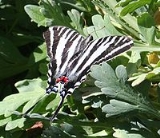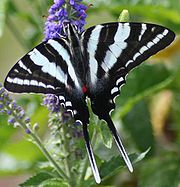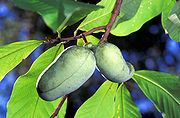
Zebra Swallowtail Butterfly
Encyclopedia
The Zebra Swallowtail is a swallowtail butterfly
native to the eastern United States
and southeast Canada
. Its distinctive wing shape and long tails make it easy to identify, and its black and white-striped pattern is reminiscent of a zebra
. The butterflies are closely associated with pawpaws
, and are rarely found far from these trees. The green or black caterpillar
s feed on the leaves of various pawpaw species, while the adults feed on flower nectar and minerals from damp soil.
 The Zebra Swallowtail has a wingspan of 6.4 centimetre. The triangular wings are white to greenish-white with black longitudinal stripes. A pair of swordlike tails extend from the hind wings. The inner margin of the hind wing has two blue spots on the corner and a red spot near the body. A red stripe runs along the middle of the ventral hind wing. P. marcellus has two seasonal forms, one occurring in the spring and the other in the summer. Spring forms are smaller, more white, and have short, black tails with white tips. Summer forms are larger, have broader black stripes, and longer, black tails with white edges.
The Zebra Swallowtail has a wingspan of 6.4 centimetre. The triangular wings are white to greenish-white with black longitudinal stripes. A pair of swordlike tails extend from the hind wings. The inner margin of the hind wing has two blue spots on the corner and a red spot near the body. A red stripe runs along the middle of the ventral hind wing. P. marcellus has two seasonal forms, one occurring in the spring and the other in the summer. Spring forms are smaller, more white, and have short, black tails with white tips. Summer forms are larger, have broader black stripes, and longer, black tails with white edges.
and southern Ontario
southeast along the Atlantic coast to Florida
and the Gulf States
west to the Great Plains
. It is extirpated from the southernmost tip of Florida due to loss of habitat. This butterfly rarely strays far from its host plant, pawpaw, and is found in habitats where the trees grow. Such habitats include deciduous woodlands, southern pine woodlands, prairies, and savannas. The Zebra Swallowtail does poorly in developed areas, and prefers intact habitats.
P. marcellus is the official state butterfly of Tennessee
.
, Brassicaceae
, Fabaceae
, Lythraceae
, Polemoniaceae
, and Rosaceae
. Males participate in a behavior known as puddling
, in which individuals congregate on sand, gravel, or moist soil to obtain salts and amino acids. These nutrients aid the male in reproduction. Other food sources include rotting fruit and urine.
s are cannibalistic, females lay their eggs
singly on pawpaw leaves or on the tree trunks. The round egg is pale green, later turing an orange-brown color. Young caterpillars are black with lighter colored transverse stripes. Older larvae have two color forms
. The more common form is green with yellow and white transverse stripes; the rarer form is black and banded with white and orange. In both forms, between the swollen thorax and the abdomen, there is a yellow, black, and bluish-white band. The larva has a yellow, foul-smelling, forked gland called an osmeterium
which it will use to deter predators, especially spider
s and ant
s. The chrysalis is either green or brown, and is more compact compared to chrysalids in the genus Papilio. Three small horns project from the head and thorax. The chrysalis hibernates
in areas of its range with cold winters.
 The Zebra Swallowtail caterpillar feeds only on species within the genus Asimina. Commonly used species include A. angustifolia (Slimleaf Pawpaw), A. incana (Woolly Pawpaw), A. parviflora (Smallflower Pawpaw), A. reticulata (Netted Pawpaw), A. tetramera
The Zebra Swallowtail caterpillar feeds only on species within the genus Asimina. Commonly used species include A. angustifolia (Slimleaf Pawpaw), A. incana (Woolly Pawpaw), A. parviflora (Smallflower Pawpaw), A. reticulata (Netted Pawpaw), A. tetramera
(Four-petal Pawpaw), and A. triloba
(Common Pawpaw). P. marcellus caterpillars ingest chemicals called annonaceous acetogenins from their host plants, which are retained in the body tissues of both the caterpillar and the adult, and may help chemically protect the butterfly from bird
s.
Swallowtail butterfly
Swallowtail butterflies are large, colorful butterflies that form the family Papilionidae. There are over 550 species, and though the majority are tropical, members of the family are found on all continents except Antarctica...
native to the eastern United States
United States
The United States of America is a federal constitutional republic comprising fifty states and a federal district...
and southeast Canada
Canada
Canada is a North American country consisting of ten provinces and three territories. Located in the northern part of the continent, it extends from the Atlantic Ocean in the east to the Pacific Ocean in the west, and northward into the Arctic Ocean...
. Its distinctive wing shape and long tails make it easy to identify, and its black and white-striped pattern is reminiscent of a zebra
Zebra
Zebras are several species of African equids united by their distinctive black and white stripes. Their stripes come in different patterns unique to each individual. They are generally social animals that live in small harems to large herds...
. The butterflies are closely associated with pawpaws
Asimina triloba
Asimina triloba, the pawpaw, paw paw, paw-paw, or common pawpaw, is a species of Asimina in the same plant family as the custard-apple, cherimoya, sweetsop, ylang-ylang and soursop...
, and are rarely found far from these trees. The green or black caterpillar
Caterpillar
Caterpillars are the larval form of members of the order Lepidoptera . They are mostly herbivorous in food habit, although some species are insectivorous. Caterpillars are voracious feeders and many of them are considered to be pests in agriculture...
s feed on the leaves of various pawpaw species, while the adults feed on flower nectar and minerals from damp soil.
Description

Distribution and habitat
The Zebra Swallowtail is found from southern MichiganMichigan
Michigan is a U.S. state located in the Great Lakes Region of the United States of America. The name Michigan is the French form of the Ojibwa word mishigamaa, meaning "large water" or "large lake"....
and southern Ontario
Ontario
Ontario is a province of Canada, located in east-central Canada. It is Canada's most populous province and second largest in total area. It is home to the nation's most populous city, Toronto, and the nation's capital, Ottawa....
southeast along the Atlantic coast to Florida
Florida
Florida is a state in the southeastern United States, located on the nation's Atlantic and Gulf coasts. It is bordered to the west by the Gulf of Mexico, to the north by Alabama and Georgia and to the east by the Atlantic Ocean. With a population of 18,801,310 as measured by the 2010 census, it...
and the Gulf States
Gulf Coast of the United States
The Gulf Coast of the United States, sometimes referred to as the Gulf South, South Coast, or 3rd Coast, comprises the coasts of American states that are on the Gulf of Mexico, which includes Texas, Louisiana, Mississippi, Alabama, and Florida and are known as the Gulf States...
west to the Great Plains
Great Plains
The Great Plains are a broad expanse of flat land, much of it covered in prairie, steppe and grassland, which lies west of the Mississippi River and east of the Rocky Mountains in the United States and Canada. This area covers parts of the U.S...
. It is extirpated from the southernmost tip of Florida due to loss of habitat. This butterfly rarely strays far from its host plant, pawpaw, and is found in habitats where the trees grow. Such habitats include deciduous woodlands, southern pine woodlands, prairies, and savannas. The Zebra Swallowtail does poorly in developed areas, and prefers intact habitats.
P. marcellus is the official state butterfly of Tennessee
Tennessee
Tennessee is a U.S. state located in the Southeastern United States. It has a population of 6,346,105, making it the nation's 17th-largest state by population, and covers , making it the 36th-largest by total land area...
.
Flight period
The Zebra Swallowtail can be seen from late March to August in the northern portion of its range and from February to December in the southern portion. It has two broods in the north and three to four in the south, with the first brood being the most numerous.Behavior
Males will patrol near host plants in search of females, flying swiftly and directly. They usually fly 0.5 to 1.8 meters (2 to 6 ft) above the ground. Females will fly slowly when searching for suitable host plants. Both sexes avidly visit flowers, including species from the families ApocynaceaeApocynaceae
The Apocynaceae or dogbane family is a family of flowering plants that includes trees, shrubs, herbs, and lianas.Many species are tall trees found in tropical rainforests, and most are from the tropics and subtropics, but some grow in tropical dry, xeric environments. There are also perennial herbs...
, Brassicaceae
Brassicaceae
Brassicaceae, a medium sized and economically important family of flowering plants , are informally known as the mustards, mustard flowers, the crucifers or the cabbage family....
, Fabaceae
Fabaceae
The Fabaceae or Leguminosae, commonly known as the legume, pea, or bean family, is a large and economically important family of flowering plants. The group is the third largest land plant family, behind only the Orchidaceae and Asteraceae, with 730 genera and over 19,400 species...
, Lythraceae
Lythraceae
Lythraceae are a family of flowering plants. It includes about 620 species of mostly herbs, with some shrubs and trees, in 31 genera. Major genera include Cuphea , Lagerstroemia , Nesaea , Rotala , and Lythrum...
, Polemoniaceae
Polemoniaceae
Polemoniaceae are a family of about 25 genera with 270-400 species of annual and perennial plants, native to the Northern Hemisphere and South America, with the center of diversity in western North America, especially in California.Only one genus is found in Europe, and two in Asia, where they...
, and Rosaceae
Rosaceae
Rosaceae are a medium-sized family of flowering plants, including about 2830 species in 95 genera. The name is derived from the type genus Rosa. Among the largest genera are Alchemilla , Sorbus , Crataegus , Cotoneaster , and Rubus...
. Males participate in a behavior known as puddling
Mud-puddling
Mud-puddling is the phenomenon mostly seen in butterflies and involves their aggregation on substrates like wet soil, dung and carrion to obtain nutrients such as salts and amino acids. This behaviour has also been seen in some other insects, notably the leafhoppers.Lepidoptera are diverse in...
, in which individuals congregate on sand, gravel, or moist soil to obtain salts and amino acids. These nutrients aid the male in reproduction. Other food sources include rotting fruit and urine.
Life cycle
Since the caterpillarCaterpillar
Caterpillars are the larval form of members of the order Lepidoptera . They are mostly herbivorous in food habit, although some species are insectivorous. Caterpillars are voracious feeders and many of them are considered to be pests in agriculture...
s are cannibalistic, females lay their eggs
Egg (biology)
An egg is an organic vessel in which an embryo first begins to develop. In most birds, reptiles, insects, molluscs, fish, and monotremes, an egg is the zygote, resulting from fertilization of the ovum, which is expelled from the body and permitted to develop outside the body until the developing...
singly on pawpaw leaves or on the tree trunks. The round egg is pale green, later turing an orange-brown color. Young caterpillars are black with lighter colored transverse stripes. Older larvae have two color forms
Polymorphism (biology)
Polymorphism in biology occurs when two or more clearly different phenotypes exist in the same population of a species — in other words, the occurrence of more than one form or morph...
. The more common form is green with yellow and white transverse stripes; the rarer form is black and banded with white and orange. In both forms, between the swollen thorax and the abdomen, there is a yellow, black, and bluish-white band. The larva has a yellow, foul-smelling, forked gland called an osmeterium
Osmeterium
The osmeterium is a fleshy organ found in the prothoracic segment of larvae of Swallowtail butterflies including Birdwings. This organ emits smelly compounds believed to be pheromones. Normally hidden, this forked structure can be everted when the caterpillar is threatened, and used to emit a...
which it will use to deter predators, especially spider
Spider
Spiders are air-breathing arthropods that have eight legs, and chelicerae with fangs that inject venom. They are the largest order of arachnids and rank seventh in total species diversity among all other groups of organisms...
s and ant
Ant
Ants are social insects of the family Formicidae and, along with the related wasps and bees, belong to the order Hymenoptera. Ants evolved from wasp-like ancestors in the mid-Cretaceous period between 110 and 130 million years ago and diversified after the rise of flowering plants. More than...
s. The chrysalis is either green or brown, and is more compact compared to chrysalids in the genus Papilio. Three small horns project from the head and thorax. The chrysalis hibernates
Hibernation
Hibernation is a state of inactivity and metabolic depression in animals, characterized by lower body temperature, slower breathing, and lower metabolic rate. Hibernating animals conserve food, especially during winter when food supplies are limited, tapping energy reserves, body fat, at a slow rate...
in areas of its range with cold winters.
Host plants

Asimina tetramera
Asimina tetramera, commonly known as the four-petal pawpaw, is a species of flowering plant endemic to the state of Florida. It is a small tree or large perennial shrub with one or more main stems. There is a total population count of about 950 plants, all of which are limited to areas in Martin...
(Four-petal Pawpaw), and A. triloba
Asimina triloba
Asimina triloba, the pawpaw, paw paw, paw-paw, or common pawpaw, is a species of Asimina in the same plant family as the custard-apple, cherimoya, sweetsop, ylang-ylang and soursop...
(Common Pawpaw). P. marcellus caterpillars ingest chemicals called annonaceous acetogenins from their host plants, which are retained in the body tissues of both the caterpillar and the adult, and may help chemically protect the butterfly from bird
Bird
Birds are feathered, winged, bipedal, endothermic , egg-laying, vertebrate animals. Around 10,000 living species and 188 families makes them the most speciose class of tetrapod vertebrates. They inhabit ecosystems across the globe, from the Arctic to the Antarctic. Extant birds range in size from...
s.
External links
- zebra swallowtail on the UF / IFASInstitute of Food and Agricultural SciencesThe University of Florida’s Institute of Food and Agricultural Sciences is a federal-state-county partnership dedicated to developing knowledge in agriculture, human and natural resources, and the life sciences, and enhancing and sustaining the quality of human life by making that information...
Featured Creatures Web site

